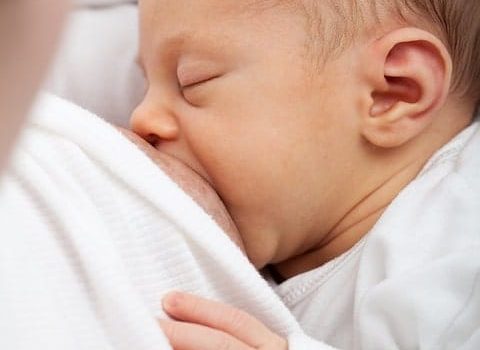Different types of blisters can appear on the nipples when breastfeeding. They can be caused by various factors, such as the friction caused when a baby doesn’t latch properly or blocked ducts.
Types of nipple blisters
Milk blisters or blocked nipple pores (milk blebs) occur when a small piece of skin grows over a milk duct opening and blocks it. The milk backs up behind the blocked duct, causing pain. A little clear, yellow or white dot is visible on the nipple. Compressing the breast and forcing milk down the ducts will make the blister bulge outwards.

White spots on the nipple may also occur due to an obstruction in the milk duct. A small clump of hardened milk or fatty, semi-solidified milk might cause the obstruction and can lead to recurrent mastitis.
Friction blisters are caused by constant pressure or rubbing. These raised bubbles containing reddish fluid can cause pain and interfere with breastfeeding. The cause may be your baby latching wrongly or incorrect use of a breast pump. It can be caused by wearing nipple shields or a nursing bra that doesn’t fit properly.
When you have a friction blister, you can continue to breastfeed, even though it may be painful. If the blister pops, it can affect the taste of the milk, causing your baby to stop feeding.
Causes of nipple blisters
The underlying causes of nipple blisters need to be established in order to treat them properly. For example, it’s possible for small, white spots to be caused by thrush and not by a blocked duct. When thrush is the culprit, the pain is likely to be worse after feeding than before, whereas a blocked duct usually feels better after feeding.

Treatment for milk blisters
The recommended treatment for milk blisters includes applying moist heat before nursing, clearing the skin from the duct, nursing with a hospital-grade pump and using medication to promote healing. This may need to be repeated until the blocked duct stays clear.
Using a solution of two teaspoons of Epsom salt to 1 cup water before breastfeeding helps to open the duct and aid in healing. First, dissolve the Epsom salt in a little bit of hot water before adding the rest of the water. You can also try placing a very hot, wet compress on the blister before nursing or using a cotton ball soaked in olive oil to soften the skin.
Nurse first on the breast with the blister using a hospital-grade pump and straight after you’ve applied the heat. The combination of the heat and nursing could cause the blister to open.
To help clear the skin from the duct, you can also rub the area with a moist washcloth or gently scrape it with a fingernail.
Additional treatments
- A massage oil that contains a few drops of grapefruit seed extract or citrus seed extract in olive oil can help to heal blisters.
- Daily saline soak and rub with a washcloth can help to prevent recurrence.
Preventing and treating friction blisters
A friction blister may be caused by your baby latching incorrectly. You need to learn the signs of a good latch. Don’t hesitate to ask for help if you can’t seem to get your baby to latch correctly.
Rotating nursing positions can also prevent the same part of your areola from getting the pressure all the time. You can also alternate the breast you begin feeding on as the baby’s latch is stronger when it begins nursing. Breaking the suction of the latch is also important when your baby has finished feeding. Place your finger at the corner of your baby’s mouth and slide your finger gently into the mouth.
It’s important that the flanges of your breast pump fit well. Don’t use the pump at consistently high levels suction or it can cause damage to your nipples. A nipple shield also needs to be used correctly.
If they do form, most friction blisters heal after about a week on their own. You can use pain relievers such as Tylenol or ice packs to relieve discomfort between feedings. Any fever, swelling, inflammation, oozing, pus or blisters that don’t heal or keep coming back are signs you need to see a medical professional
